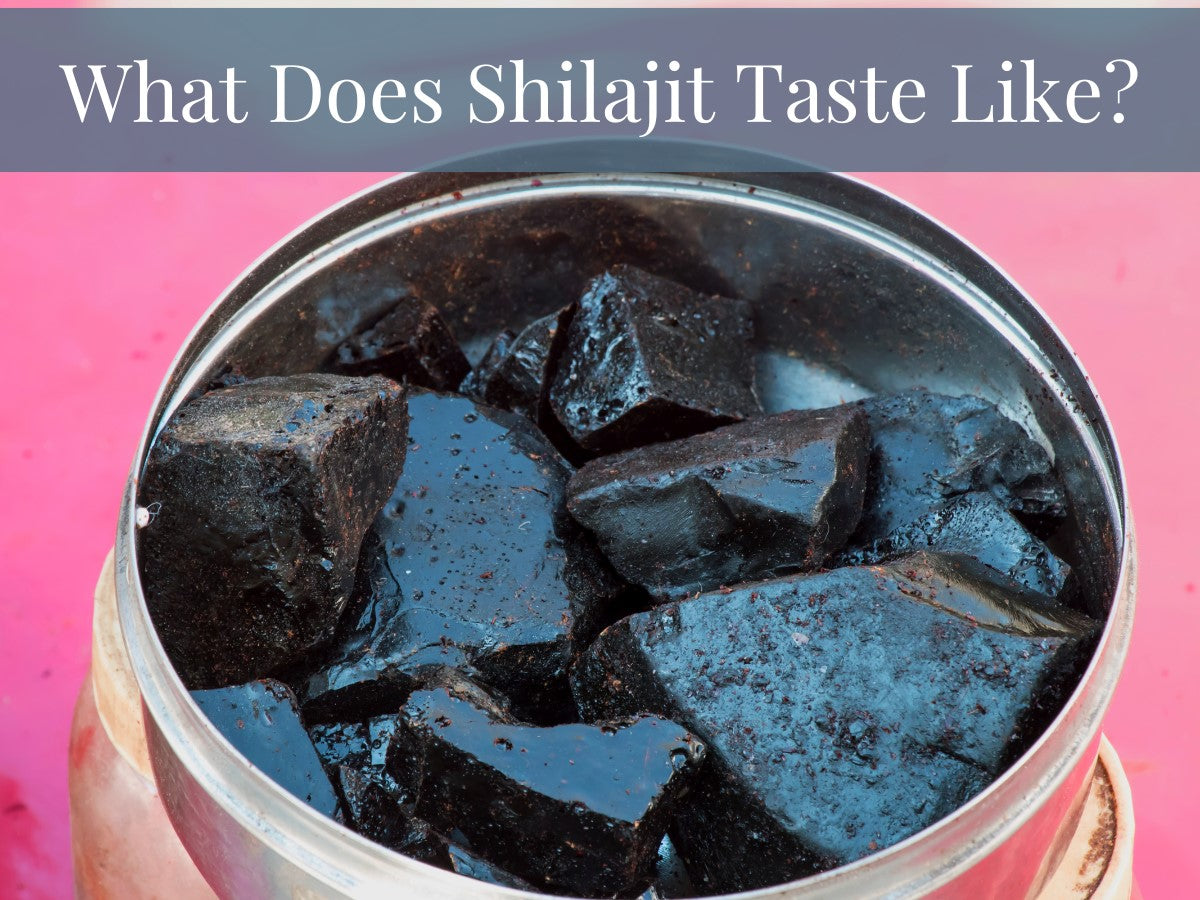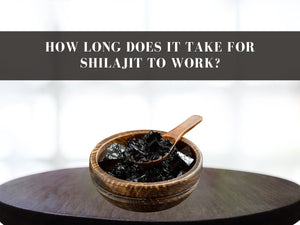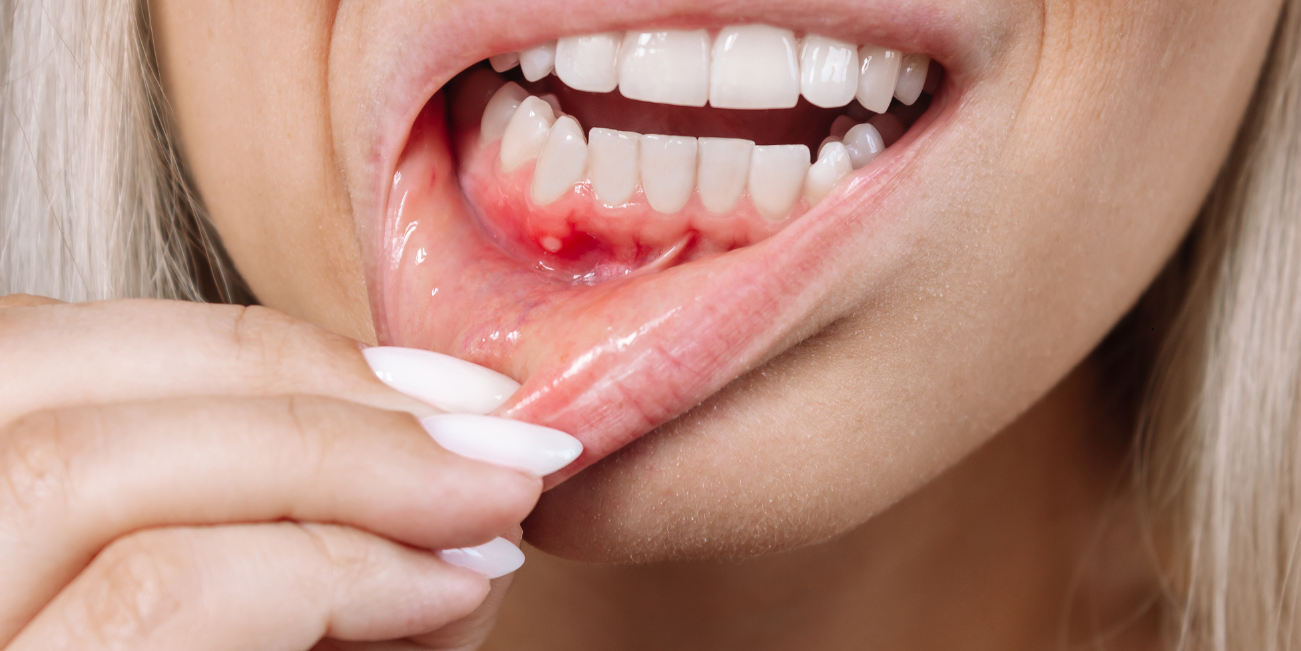Shilajit is a blackish tar-like substance with unique organoleptic properties obtained from high mountain ranges in Asia. It is a magical Ayurvedic superfood with numerous health benefits for men and women. Though its benefits outweigh its taste, texture, and odor, there is always a debate about “what does shilajit taste like?” and “how to make Shilajit taste good?” Here, you will get all the answers to your questions and ways to get the most out of it in just 4 minutes of reading.
Introduction-Common Names of Shilajit
Shilajit is also known as Shilajatu, Salajeet, Shilaras, Shilajita Mumiyo, Asphalt, Mineral wax, Barakshin, Kao- Tun, Mumijo, and Mumie in different regions of the World. Botanically or in Latin, it is called Asphaltum punjabinum. Moreover, due to its multitude of benefits, such as improving fertility, boosting virility, anti-aging properties, and managing stress, heart, and bone health, Shilajit is often touted as the Destroyer of Weakness, Fountain of Youth, Conqueror of Mountains, Sweat of Rocks, Mountain Blood, and The Immortal Elixir.
What Exactly is Shilajit?
Shilajit is a blackish-thick elixir obtained from the highest peaks of the mountains, particularly the Himalayas, Altai, Pamir, Karakoram, Afghanistan, Bhutan, Iran, Mongolia, Peru, and Caucuses. Over long years, it is formed by the decomposition and mineralization of organic matter (including plants, animals, and minerals).
This organic superfood is rich in amino acids, fatty acids, minerals, vitamins, fulvic acid, humic acid, and sterols. All these constituents have unique therapeutic properties and give exceptional health benefits to both men and women. Some popular Ayurvedic uses of Shilajit are improving fertility, managing conditions such as anemia and diarrhea, obesity, rheumatoid arthritis, jaundice, and reversing aging.
There are various naturally occurring kinds of Shilajit, notably Tamra (loaded with copper), Suvarna (packed with gold), Louha (enriched with iron), Rajat (high silver content), Naag (lead incorporated), and Vanga (rich in tin). These varieties are available in different formulations such as resin, powder, capsule, and tablet. Surprisingly, all these kinds have a distinctive texture, taste, and odor, which is a matter of debate. So, with no further wait and nitty-gritty talk, let's find out “What does Shilajit taste like?”
What Does Shilajit Taste Like?
It is normal to be curious about what a compound originated from the Earth's crust or a product obtained after years of decomposition and fermentation of organic matter tastes like. Well, Shilajit has a complex and intense flavor. It is a mix of various unique flavors and notes. Some flavors are more pronounced for some people, whereas the same notes remain unnoticeable for others.
The reason is that everyone may not have used the same Shilajit in terms of its dosage form, type, origin, years of decomposition, purification, and clarification process. Also, every human being has a different level of adaptation to the taste, and they belong to different localities with distinctive taste preferences and sensations.
Here, I’ll break down Shilajit's most prominent flavors: earthy, bitter, resinous/metallic, spicy/hot/smoky, madhura, salty, and astringent.
Earthy
Shilajit has a unique earthy flavor that resembles the scent and flavor of mud after rain. However, it does not exactly taste like mud; instead, it has a deep and grounded flavor that reflects its origin from the Earth’s crust. Moreover, since Shilajit is formed in the rocks of the high-altitude mountains through decomposition and mineralization in the presence of air and rain, it has a pleasantly earthy taste, a common note in all types of Shilajit.
Bitter
People say Shilajit is bitter, which is true because it is a decomposed form of organic matter enriched with mineral ores, complex organic compounds, and acids like fulvic acid and humic acid. However, it is not bitter for everyone, as some people adapt to its taste quickly, while others learn to mask its bitter taste well. Also, some formulations of Shilajit, like powders and capsules, do not taste bitter after excessive processing, addition of fillers, and coating.
Resinous/Metallic
Shilajit also has an unpalatable aftertaste, like that of resin or metal. This is because it is rich in minerals and vitamins that we all know have an unpleasant aftertaste. Moreover, it is resinous with a slightly medicinal flavor due to its origin, tar-like consistency, and the science behind its creation, which is direct from the mountain rocks after years of disintegration and atomization.
Spicy/Hot/Smoky
Well, Shilajit is not precisely spicy or hot like peppers; instead, it has a distinctive sharp flavor due to its rich mineral content. Some people find it spicy because of the tingling sensation on their palate. Moreover, the smoky flavor is due to its origin from rocks of warm climatic regions.
Madhura
Rasashastra, an Ayurvedic guide, describes Shilajit's taste as ‘Madhura’- a Sanskrit adjective meaning ‘sweet.’ While crude and unprocessed Shilajit is not at all sweet, this guide actually refers to one of the traditional methods of preparing Shilajit in which raw honey is added during the alkaline purification process. So, if you want a sweet-tasting Shilajit, opt for a hand-prepared one.
Salty and Astringent
Shilajit is salty and astringent because of its dense mineral content and rocky origin. The saltiness is nicely palatable and mild. It helps mask the bitterness and adds to the sweetness. However, the astringent taste is due to mineral overload and years of fermentation in harsh environmental conditions, which is a bit off-putting and gives a dry after-feeling on the tongue.
Forms of Shilajit and Their Taste
Shilajit is available in various dosage forms, such as resin, powders, and capsules. Resin is the purest and crude form of Shilajit. It is a sticky and thick blackish tar-like substance with an intense aroma and deep earthy, resinous, and bitter taste. Since it is the purest form, it is rich in minerals, metals, and vitamins, which is why the resin form has intense flavors.
Powdered Shilajit is manufactured by drying and grinding pure Shilajit resin. Though this form is a bit processed, unlike pure resin, it does retain its natural goodness and benefits. Due to processing, powder Shilajit becomes milder and less bitter, and it is also easy to blend this form into smoothies, yogurt, oatmeal, warm milk, tea, coffee, and citrus juices.
Another dosage form of this Ayurvedic superfood is the capsule, a hard edible shell enclosing powder or granules of Shilajit. Consuming this form, you will not get the taste and aroma of Shilajit at all. However, some experts say resin and powder Shilajit are more beneficial than capsules. This is due to the addition of fillers and other ingredients into capsules. Moreover, capsules are easy to carry and can be taken anytime, anywhere. So, to avoid the hassle of consuming resin or powder, opt for the Shilait capsule and still get the benefits.
Does the Smell Affect the Taste of Shilajit?
The smell does affect the taste of Shilajit. This is actually true for all foods, as 80% of their taste depends on olfaction. If you lose your sense of smell, you may not taste the foods well. Likewise, the intense and complex scent of Shilajit, with notes of earthiness, resinous, and pungency, adds to its flavor profile, making it more challenging to adapt to the taste. However, consistent use, beginning with smaller doses, may help.
How to Make Shilajit Taste Better?
Here are some tips to adapt to the taste of Shilajit if you are a first-time user and want to try this superfood for its amplitude of benefits.
#1 Start with a small dose
If you do not like a food you wish to try and be consistent with, always try with a smaller portion. A small dose, even if it has an unpleasant flavor, texture, or scent, is tolerable. Also, it is easy to deal with the aftertaste of that food supplement. Therefore, continue taking small doses regularly for a few weeks and allow your tastebuds to welcome and adapt to such a unique taste.
#2 Add sweeteners, syrups, or flavoring agents
The simplest way to mask the bitterness of Shilajit is to add sweetness. You can do this by adding honey, maple syrup, or any other syrup you regularly use with your cold coffees. You can also add caster sugar, brown sugar, or coconut sugar. Moreover, the sweetness of dried figs and dates can also be a wonder.
#3 Add it to the warm milk- Added benefits
Milk has a delightful, slightly sweet, and mild flavor that can mask the bitterness, smokiness, resinousness, or metallicness of Shilajit. Therefore, it's best to add your Shilajit to warm milk, which is itself an excellent energy-boosting drink with magical benefits for sexual health.
#4 Stir with your tea and coffee to kickstart your morning
Want to kickstart your morning with a natural energy booster? Stir your daily tea or morning coffee with a small dose of Shilajit and see the magic. It's one of the easiest and go-to tips for masking all flavors and notes of your Shilajit in an intense aroma and pleasantly pungent taste of tea and coffee.
#5 Shilajit with citrus juices
The acidic flavor of citrus juices such as orange, grapefruit, lemon, lime, and mandarins efficiently masks the metallic and salty flavor of Shilajit. So if your Shilajit is not bitter yet salty and astringent, add it to your fresh juice and take it after yoga or regular exercise.
#6 Blend into smoothies
Blend some Shiljait in your wholesome and nutritious smoothies and enjoy them happily—you won't feel as if you've taken your bitter Shiljait because of the bursting flavors of berries, fruits, milk, honey, and chia seeds.
#7 Shilajit yogurt meal
No time to make tea, fresh juices, and smoothies on early weekday mornings? No worries! Just add a small dose of Shilajit to your daily yogurt meal and get the most out of this superfood, avoiding the nasty foretaste or aftertaste.
#8 The Madhura Shilajit
Madhura Shilajit refers to the traditional hand-made Shilajit with raw honey. If you are trying this Ayurvedic superfood for the first time, get the traditionally prepared Shilajit and try to adapt to its taste.
#9 Shilajit and lemon -The weight loss recipe
Lemon, because of its citrus taste, is the best neutralizer of bitterness and saltiness. So, if you are in a hassle and cannot prepare citrus juice for yourself, just add some lemon to a glass of warm water and add your Shilajit. This recipe not only helps you accustom to the distinctive taste of Shilajit but also helps you lose weight while retaining your body vigor.
#10 Consistency leads to successful adaptation
Regularly take small doses of your superfood and slowly increase the amount to adapt to its taste. Remember, consistency is the key, and it is actually like a timeframe that not only helps your tastebuds welcome a new flavor but also adapts to it gradually.
Health Benefits that Outweigh Shilajit Taste
Here’s a list of benefits you should consider before hesitating to take Shilajit because of its unique taste.
- Promotes heart health
- Supports bone and muscle health
- Enhances stamina, virility, and libido
- Boosts immune system
- Helps manage stress, obesity, diarrhea, and jaundice
- Improves skin and hair health
- Improves sexual and reproductive health
- Increases production of testosterone, follicle-stimulating, and luteinizing hormone
- Supports cognitive function
- Improves memory and focus
- Promotes healthy aging and slows aging
- Boosts nutrient absorption
- Accelerates nutrient absorption
FAQs
What does Shilajit taste like?
Shilajit has an earthy, bitter, resinous, and slightly smoky to sweet taste. In one word, you can say Shilajit tastes like a ‘bonfire.’ However, its taste varies with the form, purification process, and individual experience. Some raw Shilajit resins are bitter and metallic. In contrast, some processed Shilajit powders are sweeter and earthier.
Is Shilajit suitable for women?
Yes, Shilajit is suitable for women, too, just like it is a powerhouse for men. This natural Ayurvedic herb is an excellent elixir for managing tiredness and lethargy in women. It also helps regulate the menstrual cycle, heart health, bone strength, and skin integrity. Shilajit also boosts the immune system in women. Moreover, it aids in managing stress and reproductive problems. Most importantly, Iron-loaded Shilajit helps manage and prevent iron deficiency in women.
How does Shilajit taste can be made good?
Raw Shilajit resin, or ‘Mountain Blood,’ is actually bitter and resinous. Still, according to Rasashastra- an Ayurvedic guide, Shilajit resin is a bit ‘Madhura,’ which means it has a slightly sweet taste. This added sweetness is due to the incorporation of raw honey during the purification process.
However, some people find it more bitter and metallic when they use it for the first time. To help adapt to the taste, you should take a smaller dose than what is recommended (typically 100-500 milligrams per day). Moreover, you can add a small amount of this ‘Mineral Pitch’ in warm milk, tea, coffee, and citrus juices. You can also add flavors or syrups to your drink to mask the unpleasant taste of Shilajit and make it drinkable.
Why Does Shilajit Taste So Bad?
The taste of Shilajit is not too bad to be unbearable or unpalatable. It is just a unique and adaptable taste; once you get used to it, you will not feel its bitterness or distinctive resinous note. The key is to start with a smaller dose, add it to something that can mask its striking flavors, and, of course, be consistent.
Are there any side effects of Shilajit?
Yes, Shilajit has some side effects, but they only appear after an allergic reaction following consumption. These include nausea, diarrhea, dizziness, stomach pain, hives, chest pain, rapid heart rate, difficulty breathing, speaking, or swallowing. However, such allergic reactions only occur in people hypersensitive to any of the components of Shilajit. These side effects may also appear if Shilajit is degraded or contaminated with fungus or if it causes metal ion toxicity in an individual.
Though there is limited scientific evidence about the side effects of Shilajit, some research done on rats suggests that Shilajit is safe and effective and does not cause any systemic irritability or toxicity (iron toxicity) when used within 90 days. No study has been conducted on animals or humans beyond 90 days of use. Therefore, the conclusion is you can use Shilajit safely if you are not allergic to it for three months.
Is Shilajit good for sex?
Shilajit- touted as the ‘Destroyer of Weakness’ and the ‘Fountain of Youth,’ is a great natural supplement for boosting sexual health. According to Ayurveda, Shilajit resin has potent aphrodisiac properties that help increase your stamina and virility during sexual performance.
If you take Shilajit resin with warm milk before sleeping, it will enhance blood circulation to your genitalia. Increased blood flow helps improve the quantity and quality of sperm and also increases your testosterone and luteinizing hormone levels. Moreover, its long-term use can help with erectile dysfunction and other sexual problems, such as decreased libido and pre-ejaculation.
Does Shilajit expire?
No, Shilajit does not expire, as it is made after years of decomposition of organic matter. However, its effectiveness may degrade over time. The reason behind its loss of efficiency and health benefits is its contamination due to improper storage. When Shilajit comes in contact with humid air and moisture, the chemicals inside the organic matter react with each other and the water, which alters its basic physical and chemical properties. This alteration of chemical integrity favors mold and bacterial growth, leading to its expiration and making it unusable.
However, pure Shilajit resin does not expire as early as the powder form or low-quality ones; instead, it remains effective for up to 2-3 years when stored appropriately in a cool, dry place, away from direct sunlight, heat, and moisture. If you notice any change in the color, texture, consistency, and odor of Shilajit, it means it is degraded and will not provide you with the required benefits. In a nutshell, high-quality Shilajit, in its uncontaminated state, is like tar with a distinctive bitter to resinous odor.
Outlook
Shilajit, a tar-like substance obtained from the high-altitude mountains of Asia, is an energy-rich elixir with a multitude of benefits for men and women. Since it is formed by decomposing organic matter (including plants, animals, and minerals) over years, it has a unique taste and a distinctive odor. Pure Shilajit resin has a bitter, earthy, hot/spicy, smoky, and resinous taste with a metallic odor. The powder form is slightly sweet after the purification process. In a word, you can say Shilajit tastes like a ‘bonfire’ or a ‘barbeque sauce sizzling in a metallic pot.’
However, the taste varies greatly depending on the purification process, dosage form, and individual experience. Mainly, if you are using it for the first time, it can be a bit more bitter for you. You can help yourself adapt to the taste by reducing the recommended dose for the first few weeks. You can also mix your Shilajit gel or powder with warm milk, tea, coffee, citrus juices, protein shakes, or milkshakes to make it taste better, as you don't want to miss its benefits because of the unique taste.













